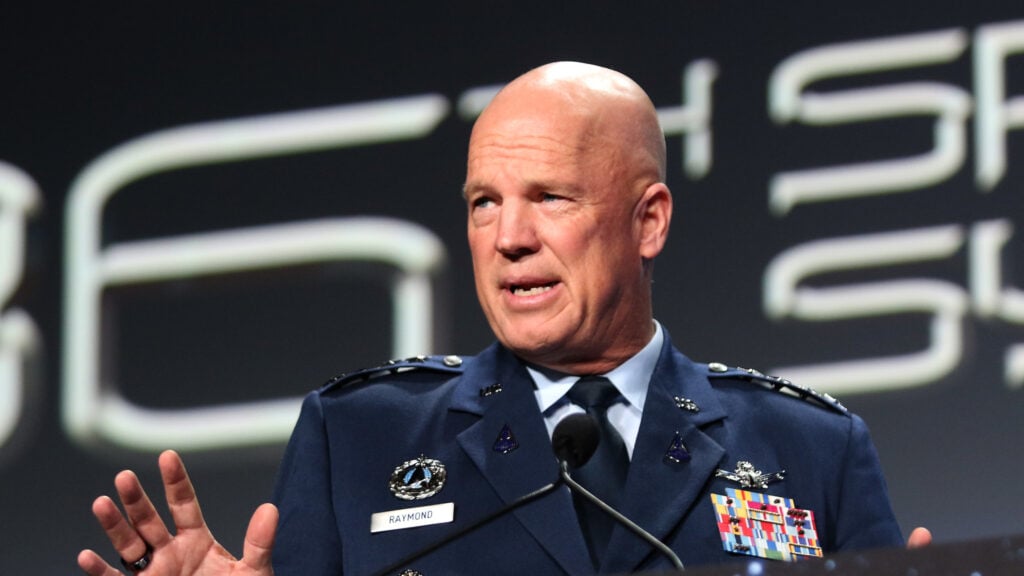
Gen. Jay Raymond appears at the 36th annual Space Symposium. (Space Foundation)
Updated 10/14/21 at 10 PM ET to include a second Air Force response.
WASHINGTON: The Department of the Air Force on Monday will put in place a realignment of initial space policy development that in the past has been directly under the purview of the Air Force secretary, handing them instead to the office of the Space Force chief, Breaking Defense has learned.
An Air Force spokesperson confirmed the planned shift in an email this evening. However, Air Force officials later tonight in a phone call stressed that decision-making authority over policy continues to reside within the civilian chain of command, starting with Air Force Secretary Frank Kendall and ultimately going through Secretary of Defense Lloyd Austin.
The move — which will make policy the purview of Lt. Gen. Bill Liquori, who serves as Space Force’s chief strategy and resourcing officer — puts initial space policy development in the military chain of command rather than in the hands of civilians appointed by Congress. It also is at least the seventh reshuffle of space policy activities within the Department of the Air Force since the early 2000s.
Chief of Space Operations Gen. Jay Raymond had pushed for the shift, arguing that there isn’t a secretariat office for air policy, one former Defense Department official explained.
“I think USSF leadership wants the Space Staff to be the one stop shop for all DAF space policy (and strategy) matters,” one insider said.
At the moment, it remains unclear where those working on policy issues under the old version of the Space Acquisition and Integration office will be reassigned.
“They have announced the top and middle tier structures and leadership, but no worker bees know where they will be assigned yet,” said another source close to the action earlier this week.
A spokesperson for the Department of the Air Force explained that Brig. Gen. Steve Whitney, who was charged with the realignment, would detail the changes to staff tomorrow.
“Brig. Gen. Whitney is presenting to the SAF/SQ team on 15 Oct the organizational structure of SAF/SQ and personnel alignment which will take effect on 18 Oct. There is not a plan for a formal announcement,” the spokesperson said in an email this evening.
“Regarding space policy, space acquisition policy remains in SAF/SQ while broader policy discussions will occur across the USSF. The shift of the international affairs efforts to SAF/IA is in progress and involves the shift of a handful of specific skilled individuals. The remaining members of SAF/SQ will be assigned to positions inside of SAF/SQ to accomplish the SAF/SQ mission set of Space System Acquisition and Integration.”
Follow The Money
Air Force Secretary Frank Kendall in August revealed his plan to merge the Space Acquisition and Integration office, formerly known as SAF/SP, with the Air Force Acquisition, Technology and Logistics office, SAF/AQ, into a new organization still named Space Acquisition and Integration, but now designated SAF/SQ. At the same time, he announced that Whitney was replacing Shawn Barnes, who served as SAF/SP deputy but had de facto been the senior civilian in charge of the office.
“The alignment of SAF/SQ duties is in-line with the previously announced changes by the SecAF at the Space Symposium conference,” the spokesperson said.
The 2020 National Defense Authorization Act required that the Air Force appoint a Senate-confirmed assistant secretary for space acquisition and integration. That person, the act said, will “synchronize with the Air Force Service Acquisition Executive on all space system efforts, and take on Service Acquisition Executive responsibilities for space systems and programs effective on October 1, 2022.”

Frank Kendall, Air For secretary, speaks at the annual Air Force Association conference in Sept. 2021. (AFA)
The reorganization, Kendall told an audience at this year’s Space Symposium in Colorado Springs, is designed to emphasize that the new office, which was mandated by Congress in the 2020 National Defense Authorization Act, is first and foremost an acquisition office, as opposed to a policy shop for space acquisition issues.
“Frank cares more about the money than he does about policy,” one outside expert following the issue said, because in the end, those with the money control what is actually bought.
More than one current and former DoD space policy wonk expressed concern about the direction of the planned reshuffle. That is in part because while Raymond has put enormous emphasis on speeding weapons development and fielding, there continue to be major policy questions surrounding what the future space architecture looks like.
For example, what is the balance between small constellations of large, highly exquisite satellites, such as the Space Based Infrared System (SBIRS) missile warning satellites and those comprised of many smaller but perhaps less capable satellites, such as the Missile Tracking layer being development by the Space Development Agency? What should be the balance of investment in offensive weapons versus building architectural resilience?
“The Space Force is going really fast! I’m not sure where they are going or what they are measuring to suggest they are going fast, but that’s what I hear!!!” the former DoD official wrote.
“They’re creating weapons before they’re realizing how they want to employ them — and that seems a little backwards to me,” said one former military space operator.
There are also issues surrounding how such decisions driving acquisition are managed, and overseen.
“The ‘space policy’ portfolio is to move to CSRO, but I don’t think they have the manning/expertise to support what is needed in the short term,” the insider said.
“Congress can hold political [appointees] accountable — not so much with the uniformed officers,” the former DoD official explained. Noting that in the past the senior space policy official would represent the Department of the Air Force at interagency meetings, the source added: “I don’t see why this would be given to someone who is loyal to the CSO rather than the secretary.”
Another former DoD official said that given Kendall’s earlier comments, the move is not unexpected. “I do think it is of questionable wisdom,” the source added.
“I think it is a mistake,” the outside expert said bluntly.
“To the question of Individuals expressing concerns about moving Policy from a civilian lead (SecAF) to a military lead (CSO): We would say, SAF/SQ is focused on the acquisition of space systems and technical capabilities. Space acquisition policy will remain in SAF/SQ while broader policy discussions will occur across the USSF and the international affairs efforts move to SAF/IA. The Department of Defense provides civilian oversight of space policy through the Office of the Assistant Secretary of Defense for Space Policy,” the spokesperson wrote.
Congress Wants Speed
To be fair to Pentagon space leaders, a frustrated Congress has been pushing DoD, the Department of the Air Force and the Space Force to move out on space acquisition reform, as well as to speed fielding of new technology to ensure the US has an edge on China and Russia.
Just last week, Chairman of the House Armed Services’ strategic forces subcommittee, Rep. Jim Cooper, D-Tenn., admonished the service to “step up its game.” Cooper, who was one of the father’s of Space Force’s creation, said that the service has the budget it needs to succeed but is still moving too sluggishly to acquire cutting-edge tech.
The House Appropriations Committee (HAC), similarly slammed the DoD space leadership in its 2022 defense spending bill for what the appropriators see as foot-dragging on space acquisition reform — which was one of the primary congressional rationales for the creation of the new space service in the first place.
The HAC report thunders:
The fiscal year 2022 budget request is the first budget developed by the Space Force since its establishment, yet jt includes many of the same type of “big juicy targets” that the current Vice Chairman of the Joint Chiefs of Staff has warned against for at least four years. The Space Force lacks a clear plan which defines its future space architecture and lacks a strategy for how this architecture will be acquired.
HASC chair backs Air Force plan on space Guard units (Exclusive)
House Armed Services Chairman Mike Rogers tells Breaking Defense that Guard advocates should not “waste their time” lobbying against the move.



























